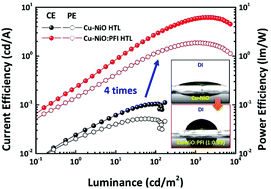Our official English website, www.x-mol.net, welcomes your
feedback! (Note: you will need to create a separate account there.)
Quantum-dot light-emitting diodes with a perfluorinated ionomer-doped copper-nickel oxide hole transporting layer†
Nanoscale ( IF 5.8 ) Pub Date : 2018-03-24 00:00:00 , DOI: 10.1039/c7nr09671b Hyo-Min Kim 1, 2, 3, 4 , Jeonggi Kim 1, 2, 3, 4 , Jin Jang 1, 2, 3, 4
Nanoscale ( IF 5.8 ) Pub Date : 2018-03-24 00:00:00 , DOI: 10.1039/c7nr09671b Hyo-Min Kim 1, 2, 3, 4 , Jeonggi Kim 1, 2, 3, 4 , Jin Jang 1, 2, 3, 4
Affiliation

|
Herein, we report all solution-processed green quantum-dot light-emitting diodes (G-QLEDs) by introducing a perfluorinated ionomer (PFI, Nafion 117) into quantum dots (QDs) to improve hole injection. To reduce the energy level mismatch between the hole transporting layer (HTL) and QDs and exciton quenching on the metal–oxide surface, a PFI-mixed copper-doped nickel oxide (Cu-NiO) HTL was introduced for G-QLEDs. Mixing Cu-NiO with a PFI increases the work function and induces phase separation between Cu-NiO and PFI; thus, energy band bending occurs on the surface such that effective hole injection can be possible. The phase-separated PFI molecules on HTL affect the thickness and compactness of G-QDs and make a smooth interface between G-QDs and HTL. The G-QLED with a PFI and Cu-NiO mixture HTL exhibits the maximum current efficiency (CEmax), power efficiency (PEmax), and external quantum efficiency (EQEmax) of 7.3 cd A−1, 2.1 lm W−1, and 2.14%, respectively, which are about 4 times those of the QLED with a Cu-NiO HTL.
中文翻译:

带有全氟离聚物掺杂的铜-氧化镍空穴传输层的量子点发光二极管†
本文中,我们通过将全氟化离聚物(PFI,Nafion 117)引入量子点(QD)中来改善空穴注入,从而报告了所有溶液处理的绿色量子点发光二极管(G-QLED)。为了减少空穴传输层(HTL)和量子点之间的能级失配以及金属氧化物表面上的激子猝灭,我们为G-QLED引入了掺PFI的掺杂铜的氧化镍(Cu-NiO)HTL。将Cu-NiO与PFI混合会增加功函,并引起Cu-NiO与PFI之间的相分离。因此,能带弯曲发生在表面上,从而可以进行有效的空穴注入。HTL上的相分离PFI分子会影响G-QD的厚度和致密性,并在G-QD和HTL之间形成平滑的界面。具有PFI和Cu-NiO混合HTL的G-QLED表现出最大的电流效率(CE最大值),功率效率(PE最大值),和外部量子效率(EQE最大值)7.3光盘的-1,2.1流明w ^ -1,和2.14%,分别,这是约4倍的那些QLED的与CU- NiO HTL。
更新日期:2018-03-24
中文翻译:

带有全氟离聚物掺杂的铜-氧化镍空穴传输层的量子点发光二极管†
本文中,我们通过将全氟化离聚物(PFI,Nafion 117)引入量子点(QD)中来改善空穴注入,从而报告了所有溶液处理的绿色量子点发光二极管(G-QLED)。为了减少空穴传输层(HTL)和量子点之间的能级失配以及金属氧化物表面上的激子猝灭,我们为G-QLED引入了掺PFI的掺杂铜的氧化镍(Cu-NiO)HTL。将Cu-NiO与PFI混合会增加功函,并引起Cu-NiO与PFI之间的相分离。因此,能带弯曲发生在表面上,从而可以进行有效的空穴注入。HTL上的相分离PFI分子会影响G-QD的厚度和致密性,并在G-QD和HTL之间形成平滑的界面。具有PFI和Cu-NiO混合HTL的G-QLED表现出最大的电流效率(CE最大值),功率效率(PE最大值),和外部量子效率(EQE最大值)7.3光盘的-1,2.1流明w ^ -1,和2.14%,分别,这是约4倍的那些QLED的与CU- NiO HTL。











































 京公网安备 11010802027423号
京公网安备 11010802027423号